Sail plan
A sail plan is a set of drawings, usually prepared by a naval architect which shows the various combinations of sail proposed for a sailing ship. Alternatively, as a term of art, it refers to the way such vessels are rigged as discussed below.[1]
The combinations shown in a sail plan almost always include three configurations:
- A light air sail plan. Over most of the Earth, most of the time, the wind force is Force 1 or less. Thus a sail plan should include a set of huge, lightweight sails that will keep the ship underway in light breezes.
- A working sail plan. This is the set of sails that are changed rapidly in variable conditions. They are much stronger than the light air sails, but still lightweight. An economical sail in this set will include several sets of reefing ties, so the area of the sail can be reduced in a stronger wind.
- A storm sail plan. This is the set of very small, very rugged sails flown in a gale, to keep the vessel under way and in control.
In all sail plans, the architect attempts to balance the force of the sails against the drag of the underwater keel in such a way that the vessel naturally points into the wind. In this way, if control is lost, the vessel will avoid broaching (turning edge-to-the wind), and being beaten by breaking waves. Broaching always causes uncomfortable motion, and in a storm, the breaking waves can destroy a lightly built boat. The architect also tries to balance the wind force on each sail plan against a range of loads and ballast. The calculation assures that the sail will not knock the vessel sideways with its mast in the water, capsizing and perhaps sinking it.
Terminology

Types of rig
- Fore-and-aft rig features sails that run fore and aft (along the length of the sailing craft), controlled by lines called "sheets", that changes sides, as the bow passes through the wind from one side of the craft to the other. Three variants include:
- Bermuda rig (also known as a Marconi rig) features a three-sided mainsail.
- Gaff rig features a four-sided mainsail with the upper edge made fast to a spar called a gaff.
- Lateen rig features a three-sided sail set on a long yard, mounted at an angle on the mast and running in a fore-and-aft direction.
- Square rig features sails set square to the mast from a yard, a spar running transversely in relation to the hull (athwartships). Although these sails are more or less "square" (trapezoid) in appearance, this is not the reason they are referred to as "square". In ships built using older designs of the square rig, sailors would have to climb the rigging and walk out on footropes under the yard to furl and unfurl the sails. In a modern square rigged design the crew can furl and unfurl sails by remote control from the deck. Some cruising craft with fore-and-aft sails will carry a small square sail with top and bottom yards that are easily rigged and hauled up from the deck; such a sail is used as the only sail when running downwind under storm conditions, as the vessel becomes much easier to handle than under its usual sails, even if they are severely reefed (shortened). A modern version of this rig is the German-engineered DynaRig which has its yards fixed permanently in place on its rotating masts and has twice the efficiency of operation of the traditional square rig.[2]
Types of sail

Each form of rig requires its own type of sails. Among them are:
- A staysail ("stays'l") is a piece of cloth that has one or two sides attached to a stay, that is, one of the ropes or wires that helps hold the mast in place. A staysail was classically attached to the stay with wooden or steel hoops, but on modern yachts are attached by clips. Sailors would test the hoops by climbing on them.
- A jib is a headsail that flies in front of the foremost vertical mast and attaches to a stay or roller furling gear, whether that be the mainmast or a somewhat shorter foremast.
- A "genoa" is a large jib that increases area by extending rearward of the mast.
- A "mainsail" is a sail attached to the main mast. For fore and aft sails it is triangular sail with the forward edge attached to the mast with the foot or lower edge generally attached to a boom. A gaff rig mainsail also has a boom at the top of the sail and is truncated triangle. For square rigged ships it is suspended on a cross spar attached to the mast, and is the lowest of such sails
- A mizzen sail is a small triangular sail at the stern of a boat.
- A lug sail is a quadrilateral sail suspended on a spar on the mast similarly to a square main sail but used as a fore and aft sail
Order
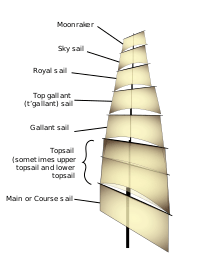
The standard terminology assumes three masts, from front to back, the foremast, mainmast and mizzenmast. On ships with fewer than three masts, the tallest is the mainmast. Ships with more masts number them.
From bottom to top, the sails of each mast are named by the mast and position on the mast, e.g. for the mainmast, from lowest to highest: main course, main topsail, main topgallant ("t'gallant"), main royal, main skysail, and main moonraker. Since the early nineteenth century, the topsails and topgallants are often split into a lower and an upper sail to allow them to be more easily handled. This makes the mast appear to have more "sails" than it officially has.
On many warships, sails above the fighting top (a platform just above the lowest sail) were mounted on separate masts ("topmasts" or "topgallant masts") held in wooden sockets called "tabernacles". These masts and their stays could be rigged or struck as the weather and tactical situation demanded.
In light breezes, the working square sails would be supplemented by studding sails ("stuns'l") out on the ends of the yardarms. These were called as a regular sail, with the addition of "studding". For example, the main top studding sail.
Between the main mast and mizzen as well as between main mast and foremast, the staysails between the masts are named from the sail immediately below the highest attachment point of the stay holding up that staysail. Thus, the mizzen topgallant staysail can be found dangling from the stay leading from above the mizzen (third) mast's topgallant sail (i.e., from the mizzen topgallant yard) to at least one and usually two sails down from that on the main mast (the slope of the top edge of all staysail lines runs from a higher point nearer the stern to a lower point towards the bow).
The jibs --staysails between the first mast and the bowsprit-- are named (from inner to outer most) fore topmast staysail (or foretop stay), inner jib, outer jib and flying jib. Many of the jibs' stays meet the foremast just above the fore topgallant. A fore royal staysail may also be set.
Lines
In the age of sail, lines were made of manila, cotton, hemp, or jute. Modern lines are made of polyester (Dacron), polyamides (nylon), and sometimes crystallized hydrocarbons (Kevlar and Spectra). Standing rigging may include wire rope made of stainless or galvanized steel. Other older, or less common materials include papyrus in ancient Egypt and coir.
Rigging
- Standing rigging does not change position. Usually it braces the masts.
- Running rigging is used to adjust sails and anchors.
- A line is a rope that has been put to use aboard a sailing vessel.
- A stay is a wire or rope that supports a mast. It is part of the standing rigging, usually located in the fore-aft plane of the vessel.
- A shroud is similar to a stay, but is located in the athwartship plane of the vessel. Thus, shrouds come down to the sides of the boat and are attached to chainplates. Shrouds may be held away from the mast by spreaders.
- A vang is a rope used to pull something around or down.
- A boom vang pulls down on a boom.
- A sheet is a line used to adjust the position of a sail so that it catches the wind properly.
- Halyards (from "haul-yard") are the lines on which one pulls to hoist something; e.g. the main-topgallant-staysail-halyard would be the line on which one pulls to hoist (unfurl) the main-topgallant-staysail.
- A block is the seaman's name for a pulley-block. It may be fixed to some part of the vessel or spars, or even tied to the end of a line.
- The sheave is the wheel within a block, or a spar, over which a line is rove.
- A fiddle block has two or more sheaves in one block, each with its own axle, so the sheaves are aligned.
- A snatch-block can be closed around a line, to grab the line, rather than threading the end of the line through the block.
- A shackle is a piece of metal to attach two ropes, or a block to a rope, or a sail to a rope. Customarily, a shackle has a screw-in pin which often is so tight that a shackle-key must be used to unscrew it. A snap-shackle does not screw, and can be released by hand, but it is usually less strong or more expensive than a regular shackle.
- Running lines are made fast (unmoving) by belaying them to (wrapping them around) a cleat or a belaying-pin located in a pin-rail or fife-rail. Wrapping the rope holds it tight and prevents the line from slipping, i.e. stops it. Thus to "belay" something meant to stop or cease it in naval slang ("belay that noise!").
Sprit and stays
- Bowsprit, a horizontal spar extending from the bow (front) of the boat used to attach the forestay to the foremost mast. Sails which attach to the stays of the bowsprit are called forestaysails.
- Bobstays, a heavy stay directly below the bowsprit attaching on the above the waterline on the stem to the bowsprits end, often the strongest on a ship, frequently made of chain.
- Whisker Stays, any number of pair of stays on either side of the bowsprit and jib boom bracing them against lateral forces
- Jib boom, a horizontal spar completely outboard the vessel and laying on top of the bowsprit. Used to fly the jibs from and attach the upper forestays to the higher masts.
- dolphin striker, Under the tip of the bowsprit runs downward a heavy pole to provide tension to the jib boom
- Martingale backstays, a pair of stays on either side of the bobstay run to the bottom of the dolphin striker sometimes from the cathead
- martingale, a stay that ends from the bottom of the dolphin striker to the end of the jib boom
The stays on a ship roughly form hoops of tension holding the masts up against the wind. Many ships have been "tuned" by tightening the rigging in one area, and loosening it in others. The tuning can create most of the stress on the stays in some ships.
Types of sailing vessels

Sailing vessels may be distinguished by:
- hull configuration (monohull, catamaran, trimaran),
- keel type (full, fin, wing, centerboard etc.),
- purpose (sport, racing, cruising),
- number and configuration of masts
- sail plan (square and/or fore-and-aft rigged sails).




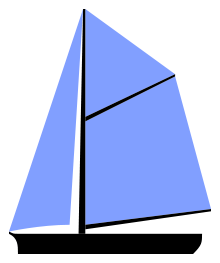






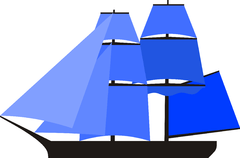
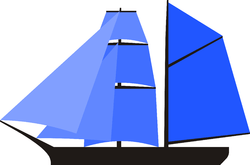
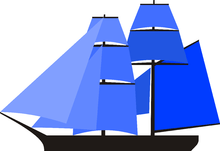
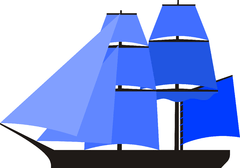
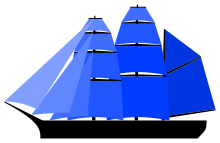


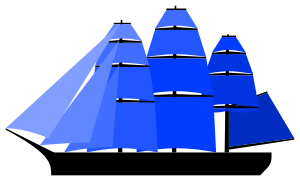


Types of sails
Quadrilateral sails
 A single loose-footed square sail was used on Viking longships, making them technically catboats.
A single loose-footed square sail was used on Viking longships, making them technically catboats.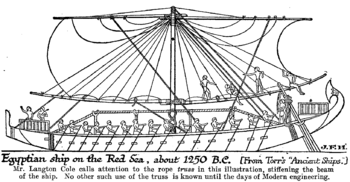 A square sail on an ancient Egyptian vessel boom, giving better sail control.
A square sail on an ancient Egyptian vessel boom, giving better sail control. A junk-rigged catboat, with multiple horizontal battens controlling the sail (sheets not shown; see diagram)
A junk-rigged catboat, with multiple horizontal battens controlling the sail (sheets not shown; see diagram) A lugsail catboat: like the loose-footed square sail (left), but the yard is hauled off-center rather than hanging balanced on the mast, which lets it sail more nearly upwind.
A lugsail catboat: like the loose-footed square sail (left), but the yard is hauled off-center rather than hanging balanced on the mast, which lets it sail more nearly upwind. A settee sail is like a lugsail, but has a very short fourth side, making it behave more like a lateen (described below).
A settee sail is like a lugsail, but has a very short fourth side, making it behave more like a lateen (described below). A similar gaff-rigged catboat, with one side of the sail along the mast, one along the gaff at the top, and one along the boom at the bottom.
A similar gaff-rigged catboat, with one side of the sail along the mast, one along the gaff at the top, and one along the boom at the bottom.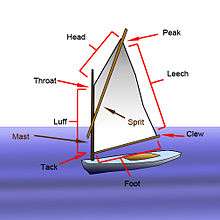 A spritsail catboat, with the peak of the sail supported by a diagonal sprit
A spritsail catboat, with the peak of the sail supported by a diagonal sprit
Triangular sails
 This Bermuda catboat has one side of the sail attached to the mast
This Bermuda catboat has one side of the sail attached to the mast A settee sail has a very short fourth sail side, putting it between a lug sail (above), and a lateen (right).
A settee sail has a very short fourth sail side, putting it between a lug sail (above), and a lateen (right).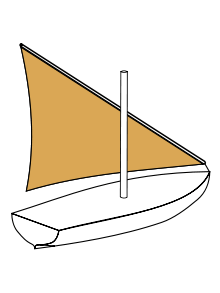 A lateen is like a lugsail, but triangular. It is loose-footed.
A lateen is like a lugsail, but triangular. It is loose-footed. A crabclaw sail is not loose-footed. It has spars along two sides. The Sunfish shown here is a crabclaw catboat with an unstayed mast.
A crabclaw sail is not loose-footed. It has spars along two sides. The Sunfish shown here is a crabclaw catboat with an unstayed mast.
Trivia
All of these sails may have a boom along the bottom, or they may have none. A boom-footed sail gives better control of the sail shape and thus makes the sail more efficient, especially upwind. One of the advantages of loose-footed sails is that there is no boom to hit one's head or knock one into the water. Boats without booms are also lighter and cheaper to make.
Some gaff and some junk rigs get in the way of shroud lines strung between the mast and hull. If the mast cannot be held up by shrouds, it must stand up by itself, which makes it heavier, especially on a large boat.
A gunter rig is often used for smaller boats where the mast is frequently taken down; the mast is made short enough to be stored flat inside the boat. The popular Mirror class of racing dinghy is gunter-rigged for this reason.
Lug, lateen and settee sails have an efficient tack and an inefficient tack, in which the sail presses against the mast, spoiling its aerodynamics. Some swing their yards around the mast to make both tacks efficient, but this is difficult with larger sails.
Crab-claws are easily to construct, as they work well when cut from a single flat sheet (they don't need multiple shaped pieces to create their 3-D draft). On a small boat like the Sunfish, their rigging can also be limited to one sheet and one halyard.
Junk rigs, like crab-claws, place no extreme loads anywhere on the sail or rigging, so they can be built using light-weight, weaker, less-expensive materials. The subdivided sails make them easy for a small crew to handle, and they are easy to reef. Junks also customarily have internal water-tight bulkheads, as do modern ships.
Aspect ratio
The sails above vary in shape from square to triangular. A triangular sail has half the surface area of a squarish sail of the same height. For the sails to have the same surface area, the triangular sail must be twice as tall.
There are several disadvantages to a tall rig. Firstly, it makes the boat less stable. If the sails are tall, the wind tends to push the boat over (the center of effort of the sail pushes sideways higher on the mast). A boat is also more tippy if it has a taller mast or heavy spars high up (such as the gaff on a gaff rig). An outrigger, ballast, and/or a long keel is needed to keep the boat upright. Secondly, a taller rig makes it harder to hold the mast onto the boat (with the standing rigging). Generally, taller rigs are more highly stressed structures than shorter rigs. This makes them more expensive and more fragile for a given strength of material. Stronger, cheaper modern materials are one reason why shorter, squarer rigs are becoming rare.
Why, then, use a tall triangular sail? Because it is more aerodynamic than a squarish one. Downwind, a sail acts like a windsock; the wind just hits and bounces, pushing the boat downwind. But at right angles to the wind, the sail catches the wind and redirects it, letting it sail faster than the wind. Pushing the wind around to a different direction pushes the sailboat off in the opposite direction (modified by the forces from the hull, which are all that stop the boat from blowing away). A sailboat can't sail directly upwind, but by redirecting the wind it can sail nearly upwind. It can then tack in a zigzag to move directly upwind.
A tall, thin sail redirects the wind more smoothly, so it can sail more nearly upwind than a wide sail (it is more weatherly). Sailing a race in a circle, everyone has to go upwind. So other things (like sail area) being equal, the most weatherly boat will win. This is why almost all racing boats have tall, thin sails. They also have deep, heavy keels, or are multihulls, so that they don't tip over, and strong standing rigging, so their masts don't blow off.
Boats with shorter, wider sails have lighter, shallower hulls. They may wait for a favorable wind to avoid sailing upwind. They may go faster than a high-aspect-ratio sailboat when not going upwind; for instance, crab-claws sail extremely well on a beam reach.
Distinctions in nomenclature
 A four-masted barque, square-rigged on the first three masts. One or more fore-and-aft sails on the aftmost mast help a ship steer and turn.
A four-masted barque, square-rigged on the first three masts. One or more fore-and-aft sails on the aftmost mast help a ship steer and turn. A five-masted square-rigged ship. All the masts bear square sails.
A five-masted square-rigged ship. All the masts bear square sails.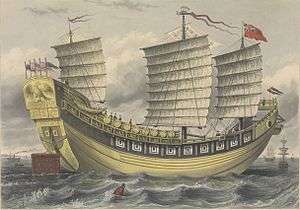 A three-masted junk ship, an 800-ton trading vessel of the mid-1800s
A three-masted junk ship, an 800-ton trading vessel of the mid-1800s A three-masted junk ship, more fore-and-aft than the 1800s junk
A three-masted junk ship, more fore-and-aft than the 1800s junk A felucca with three lateens. Feluccas with one or two are also possible.
A felucca with three lateens. Feluccas with one or two are also possible.
 A Hawai'ian waʻa kaulua with a slightly different rig; the aft sail is partly furled.
A Hawai'ian waʻa kaulua with a slightly different rig; the aft sail is partly furled.
European, and especially English, watercraft terminology draws a strong distinction between square-rigged vessels (with square sails hung from yards mounted centrally and horizontally from masts) and fore-and-aft rigged ones (everything else). It is important to note that any other sail (such as a lug or spritsail), even if it is geometrically square, is not a square sail in the technical sense used in European sail terminology. It is merely a quadrilateral fore-and-aft sail. Vessels are named by the number of square-rigged masts that they have. This is because square-rigged vessels used to be the fastest rig, and more masts were faster.
Any traditional European vessel that really needed speed was square-rigged. Navy sailing vessels, pirates, merchants that needed to escape pirates, and merchant vessels that just needed speed, such as tea clippers, all had towering stacks of smallish square sails. Given a huge crew to control all the sails, they could often outrace the fore-and-aft rigged vessels of the day, even upwind. They needed more tacks, so they had to go further, but they had nearly twice the sail area, so they went more quickly and still got there sooner. A fore-and-aft rigged vessel, with its less sub-divided sails, would break its masts and rigging if it tried to carry the same area of sail and go equally fast. Stronger materials (and winch technology to control large sails) now let fore-and-aft rigged vessels outrace square-rigged ones.
Junk rigs essentially have the stack of sails, but without all the gaps between them. Where the yards controlled the towers of square sails, the battens controlled the junk sail. In East Asia, the largest and the smallest boats traditionally use junk sails, and vessels are not named by sail type, but by region, function, and other characteristics.
Likewise, in the Pacific both large and small sailing vessels traditionally use what are generally called crabclaw sails, although they are of many different types. Other sails are also traditionally used.
In the Middle East, on the east coast of Africa, and as far east as India, lateens and settees were in common use. Ships were named more with regard to purpose than number of masts or type of sail. For instance, feluccas and sambuks were mostly used for fishing and ferrying, dhows are heavy cargo vessels. Xebecs, which also had oars, were used by corsairs to outpace merchant vessels, which were also often xebecs.
Attempts to blend nomenclature, as in the junk diagram to the left above, occur. A ship can be rigged with one of its sails as a junk sail and another as a Bermuda rig without being considered a junk vessel.
Catboat (one mast, one sail)
A catboat is a sailboat with a single mast and single sail; for examples of the variety of catboats, see the section above. This is the easiest sail plan to sail, and is used on the smallest and simplest boats. The catboat is a classic fishing boat. A popular movement for home-built boats uses this simple rig to make "folk-boats".
The term "catboat" is usually qualified by the type of sail, for example, "a gaff catboat".
Proa
 Pacific proa, on a beam reach rightwards, with the wind blowing into the page.
Pacific proa, on a beam reach rightwards, with the wind blowing into the page. Atlantic proa. Note that the wind is on the other side, blowing out of the page.
Atlantic proa. Note that the wind is on the other side, blowing out of the page.
A proa has one sail, and is thus a catboat, though it is rarely called a catboat. Both ends are alike, and the boat is sailed in either direction, but it has a fixed leeward side and a windward side. The boat is shunted from beam reach to beam reach to change direction, with the wind over the side, a low-force procedure. The bottom corner of the crabclaw sail is moved to the other end, which becomes the bow as the boat sets off back the way it came. The mast usually hinges, adjusting its rake (mast). The proa is a low-stress rig, which can be built with simple tools and low-tech materials, but it is extremely fast. On a beam reach, it may be the fastest simple rig.
In a traditional Pacific proa, the outrigger (ama) lies on the windward side of the main hull (vaka), with its weight helping keep the proa upright. The ama is very thin, to punch through waves, smoothing the ride. The first Europeans, building proas from travelers' reports, built Atlantic proas, with the outrigger on the leeward side, with its buoyancy keeping the proa upright.
"To be clear, we can blame Richard C. Newick for the debate" (about racing proas), "since it was he who came up with the Atlantic proa in the first place, with his groundbreaking Cheers - the “giant killer” that came in third in the 1968 OSTAR. Unlike all proas until Cheers, Newick placed the ama to lee and the rig to windward, concentrating all the ballast to windward and thus multiplying the righting moment."[4]
Sloop (one mast, two sails)
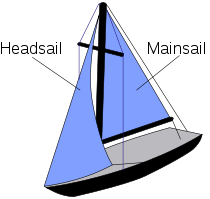
 Gunter-rigged sloop. The sail shape is intermediate between Bermuda and gaff sails.
Gunter-rigged sloop. The sail shape is intermediate between Bermuda and gaff sails. Gaff-rigged sloop with a headsail and a gaff topsail.
Gaff-rigged sloop with a headsail and a gaff topsail. Spritsail sloop
Spritsail sloop
A Bermuda or gaff mainsail lifted by a single mast with a single jib attached to a bowsprit, bent onto the forestay, held taut with a backstay. The mainsail is usually managed with a spar on the underside called a "boom".
A Bermuda-rigged sloop is one of the best racing rigs per square foot of sail area as is it very weatherly, making it faster on upwind passages. This rig is the most popular for recreational boating because of its potential for high performance. On small boats, it can be a simple rig. On larger sloops, the large sails have high loads, and one must manage them with winches or multiple purchase block-and-tackle devices.
Cutter (one mast, three or more sails)

 Gaff cutter with a gaff sail (the quadrilateral one below the gaff), two headsails, and a gaff topsail above the gaff.
Gaff cutter with a gaff sail (the quadrilateral one below the gaff), two headsails, and a gaff topsail above the gaff. Naval cutter with a square topsail hoisted. It also has a gaff sail aft, and two headsails. It is not currently carrying a gaff topsail, though it might use one when going upwind.
Naval cutter with a square topsail hoisted. It also has a gaff sail aft, and two headsails. It is not currently carrying a gaff topsail, though it might use one when going upwind.
A small single-masted ship with three or more sails. A common rig is a gaff-rigged mainsail, multiple headsails, and, often, a gaff- or square-rigged topsail above. Sometimes cutters also had an additional square-rigged mainsail when traveling downwind. The mast was normally set amidships, and two or more headsails were set from the mast to the running bowsprit.[5] Considered better than a sloop for light winds; it is also easier to manage, as the sail area is more subdivided.
Two-masted vessels
Lugger


A lugger is a two-masted vessel, with for each mast a sail plan similar to a gaff rig. The lug sails it uses, however, do not have gaffs, that attach directly to its masts. Instead, the spars are allowed to move forward and aft of the mast and are managed through a series of lines that attach to the yards and to the corners of the sails. Each sail may or may not have a boom along its foot. In Scotland, when constructed with a main dipping lug sail and a mizzen standing lug sail, such vessels are known as fifies, sailing fifies, or herring drifters; they were often used for herring fishing.
Yawl



A small ship, fore-and-aft rigged on its two masts, with its mainmast much taller than its mizzen and with or without headsails. The mizzen mast is located aft of the rudderpost, sometimes directly on the transom, and is intended to help provide helm balance.
Ketch




A small ship with two masts, both fore-and-aft rigged, with the mizzen located well forward of the rudder post and of only slightly smaller size than the mainmast (if the height of the masts were reversed—the taller in the back and the shorter in the front—it would be considered a schooner). If square-rigged on her mainmast above the course, it is called a "square topsail ketch". Historically the mainmast was square-rigged instead of fore-and-aft, but in modern usage only the latter is called a ketch. The purpose of the mizzen sail in a ketch rig, unlike the mizzen on a yawl rig, is to provide drive to the hull. A ketch rig allows for shorter sails than a sloop with the same sail area, resulting in a lower center of sail and less overturning moment. The shorter masts, therefore, reduce the amount of ballast and stress on the rigging needed to keep the boat upright. Generally the rig is safer and less prone to broaching or capsize than a comparable sloop, and has more flexibility in sail plan when reducing sail under strong crosswind conditions—the mainsail can be brought down entirely (not requiring reefing) and the remaining rig will be both balanced on the helm and capable of driving the boat. The ketch is a classic small cargo boat.
Schooner


A fore-and-aft rig having at least two masts, with a foremast that is usually smaller than the other masts. Schooners have traditionally been gaff-rigged and in small craft are generally two-masted, however many have been built with marconi rigs (and even junk rigs) rather than gaffs and in the golden age of sail, vessels were built with as many as seven masts. One of the easiest types to sail, but performs poorly to windward without gaff topsails. The extra sails and ease of the gaff sails make the rig easier to operate, though not necessarily faster, than a sloop on all points of sail other than up-wind. Schooners were more popular than sloops prior to the upsurge in recreational boating. The better performance of the sloop upwind was outweighed for most sailors by the better performance of the schooner at all other, more comfortable, points of sail. Advances in design and equipment over the last hundred years have diminished the advantages of the schooner rig. Many schooners sailing today are either reproductions or replicas of famous schooners of old.
Topsail schooner


This type of vessel has two masts, each made of two spars. The mainmast is rigged exactly like the mainmast of any other schooner (i.e., fore and aft mainsail and gaff rigged topsail) but the foremast, though having the typical schooner's fore and aft rigged mainsail, has above it one or more square-rigged topsails. The arrangement requires the ship to have a foremast yard (the lowest) from which no sail hangs. The foremast and all of its sails are comparable to that of a brigantine (see below). If there are square-rigged topsails on both masts, then it is called a two topsail schooner or double topsail schooner.[6]
Bilander

The bilander is a two-masted vessel, the foremast carrying square rigs on all of its yards and its taller mainmast having a long lateen mainsail yard with corresponding trapezoidal sail and rig inclined at about 45° with square rigs on the yards above that, the lowermost secured at the corners by a crossjack. The design was popular in the Mediterranean Sea as well as around New England in the first half of the 18th century but was soon surpassed by better designs. It is considered the forerunner of the brig.[6]
Brig
In American parlance, the brig encompasses three classes of ship: the full-rigged brig (often simply called a "brig"), the hermaphrodite brig, and the brigantine. All American brigs are defined by having exactly two masts that are entirely or partially square-rigged. The foremast of each is always entirely square-rigged; variations in the taller mainmast are what define the different subtypes [6] (The definition of a brig, brigantine, etc. has been subject to variations in nation and history, however, with much crossover between the classes).
Full-rigged brig

For the full-rigged brig, the foremast and mainmast each has three spars, all of them square rigged. In addition, the mainmast has a small gaff-rigged sail mounted behind ("abaft") the mainmast.
Hermaphrodite brig

.png)
_fore_course.png)
On a hermaphrodite brig, also called a "half brig" and a "schooner brig", the main mast carries no yards: it is made in two spars and carries two sails, a gaff mainsail and gaff topsail, making it half schooner and half brig (hence its name). If it also carries one or more square-rigged topsails on the mainmast, it is then considered a "jackass brig".[6] Some authors have asserted that this type of sail plan is that of a brigantine.[7]
Brigantine

Like the hermaphrodite brig, a brigantine also has a main (second) mast made in two spars, and its large mainsail is also fore and aft rigged. However, above this it carries two or three square-rigged yards instead of a gaff topsail (the hermaphrodite brig retains the gaff topsail), and carries no square-rigged sail at all on its lowermost yard of its mainmast (the full-rigged brig retains a square-rigged sail in this position, making it very difficult to visually distinguish at a distance from a brigantine).[6]
Snow

Although superficially similar in appearance to the brig or brigantine, the snow is a much older three masted design which evolved from the larger fully rigged ship. The foremast and mainmast are both square-rigged, but the fore and aft rigged spanker sail is attached to a small trysail mast (or in modern times a steel cable) stepped directly behind the mainmast. This "snow-mast" allows the gaff to raised unhindered by the mainmast and higher than the main yard, which in turn also allows the snow to fly a main course without complications.
Three-masted vessels
Barque


Three masts or more, square rigged on all except the aftmost mast. Usually three or four-masted, but five-masted barques have been built. Lower-speed than a full-rigged ship, especially downwind, but requiring fewer sailors than a full-rigged ship. Optimum rig for transoceanic voyages. This is a classic windjammer rig.
Barquentine or Schooner Barque

A three-masted vessel, square-rigged on the foremast and fore-and-aft rigged on the main and mizzen masts. Some sailors who have sailed on them say it is a poor-handling compromise between a barque and a ship, though having more speed than a barque or schooner.
Polacre

A three master with a narrow hull, carrying a square-rigged foremast, followed by two lateen sails. The same vessel, if she substituted her square-rigged mast with another lateen rigged one, would be called a xebec.
Fully rigged or ship-rigged ship
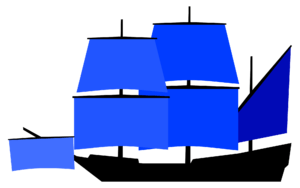



Three or more masts, square-rigged on all, usually with stay-sails between masts. Occasionally the mizzen mast of a ship-rigged ship would have a fore-and-aft sail as its course sail (top image), but in order to qualify as a "fully rigged ship" the vessel would need to have a square-rigged topsail mounted above this (thus distinguishing the fully rigged ship from, say, a barque—see above). The classic ship rig (top) originally had exactly three masts, but later, four- and five-masted ships were also built (bottom). The classic sailing warship—the ship of the line—was full rigged in this way, because of high performance on all points of wind. In particular, studding sails or topping sails could be easily added for light airs or high speeds. Square rigs have twice the sail area per mast height compared to triangular sails, and when tuned, more exactly approximate a multiple airfoil, and therefore apply larger forces to the hull. Windage (drag) is more than triangular rigs, which have smaller tip vortices. Therefore, historic ships could not point as far upwind as high-performance sloops. However, contemporary Marconi rigs (sloops, etc.) were limited in size by the strength of available materials, especially their sails and the running rigging to set them. Ships were not so limited, because their sails were smaller relative to the hull, distributing forces more evenly, over more masts. Therefore, due to their much larger, longer waterline length, ships had much faster hull speeds and could run down or away from any contemporary sloop or other Marconi rig, even if it pointed more upwind. Schooners have a heavier rig and require more ballast than ships, which increases the wetted area and hull friction of a large schooner compared to a ship of the same size. The result is that a ship can run down or away from a schooner of the same hull length. Ships were larger than brigs and brigantines, and faster than barques or barquentines, but required more sailors. Also called "ship-rigged".
Sail-plan measurements

Every sail plan has maximum dimensions.[8][9] These maxima are for the largest sail possible and they are defined by a letter abbreviation.
- J The base of the foretriangle measured along the deck from the forestay pin to the front of the mast.
- I The height measured along the front of mast from the jib halyard to the deck.
- E The foot length of the mainsail along the boom.
- P The luff length of the mainsail measured along the aft of the mast from the top of the boom to the highest point that the mainsail can be hoisted at the top of the mast.
- Ey The length of a second boom (For a Ketch or Yawl).
- Py The height of the second mast from the boom to the top of the mast.
See also
Notes
- ↑ Folkard, Henry Coleman (2012). Sailing Boats from Around the World: The Classic 1906 Treatise. Dover Maritime. Courier Corporation. p. 576. ISBN 9780486311340.
- ↑ Perkins, Tom; Dijkstra, Gerard; Navi, Perini; Roberts, Damon (2004), The Maltese Falcon: the realization (PDF), International HISWA Symposium on Yacht Design and Yacht Construction, retrieved 7 September 2016
- ↑ "Calling The Wind of Reunion". Vaka.org. 2 January 2017. Retrieved 3 January 2018.
- ↑ "Proa File - Discussion Forum". ProaFile.com. Retrieved 3 January 2018.
- ↑ Nicholas Blake; Richard Lawrence (August 2005). The Illustrated Companion to Nelson's Navy. Stackpole. p. 46. ISBN 978-0-8117-3275-8.
- 1 2 3 4 5 John Robinson; George Francis Dow (1922). The Sailing Ships of New England, 1607-1907. Marine Research Society. pp. 28–30.
- ↑ John Harper (30 November 2010). Ghostly Tales on Land and Sea. F+W Media. p. 57. ISBN 978-1-4463-5004-1.
- ↑ "Sail Measurement Assistance". www.SecondWindSails.com. Retrieved 3 January 2018.
- ↑ "hoodsailmakers.com". www.HoodSailMakers.com. Retrieved 3 January 2018.
Further reading
- Bolger, Philip C. (1998). 103 Sailing Rigs "Straight Talk". Gloucester, Maine: Phil Bolger & Friends, Inc. ISBN 0-9666995-0-5.
External links
| Wikimedia Commons has media related to Sail-plan. |
